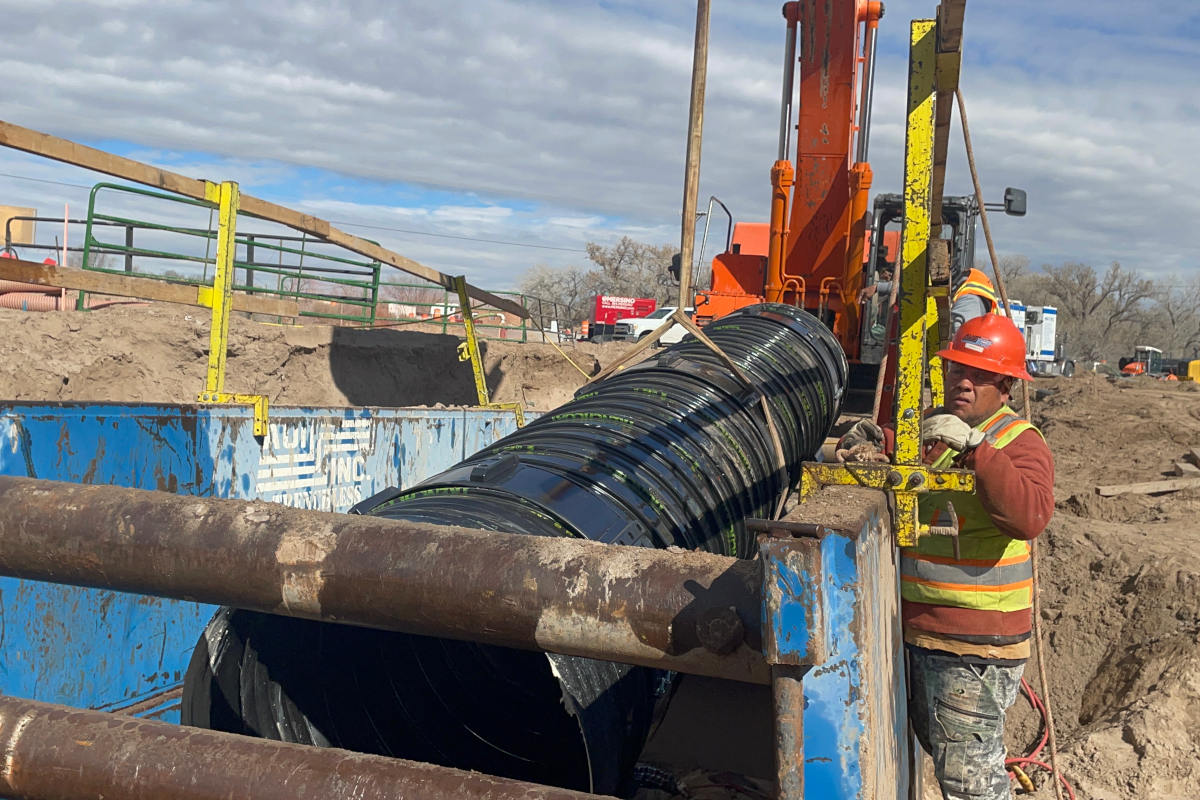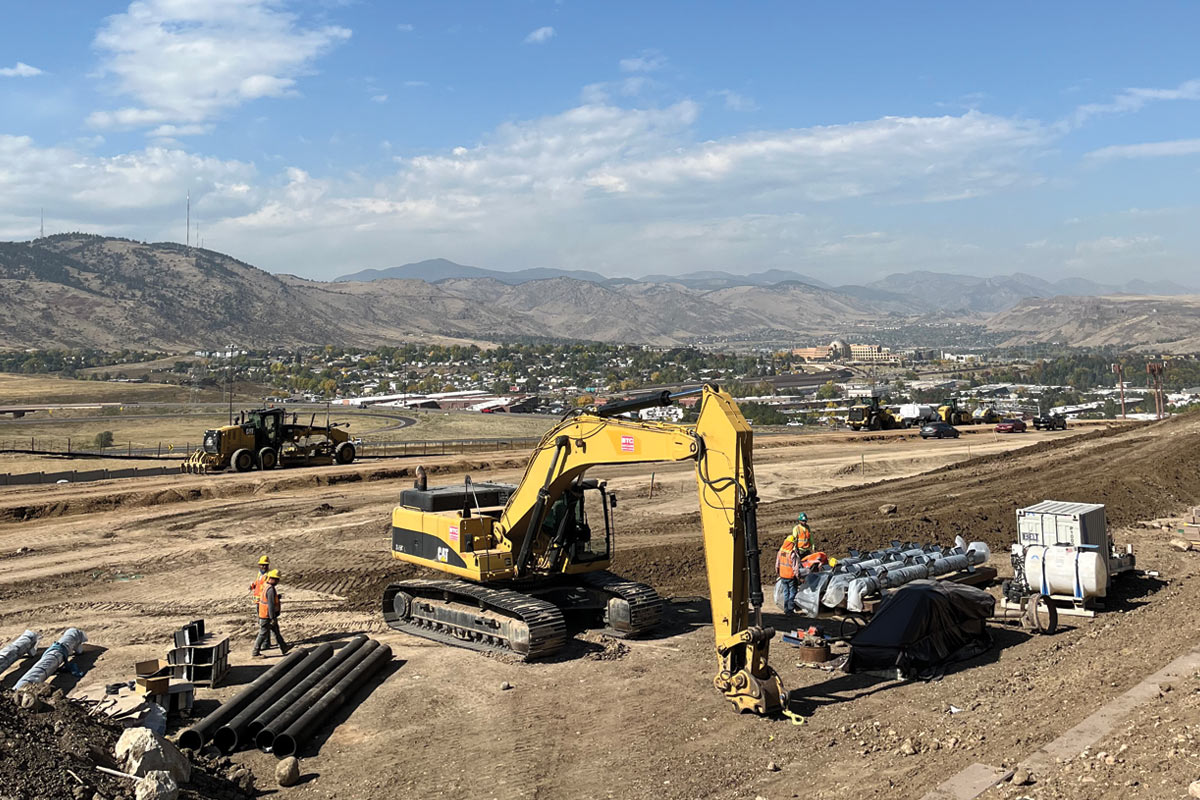
Combining UV, Bluelight CIPP Systems Beneath Denver International Airport
In 2012, Denver International Airport (DEN) needed to rehabilitate 400 lf of failing 6- and 12-in. diameter cast iron sewer pipe beneath its Jeppesen Terminal. Open-cut removal and replacement of the pipe was not feasible, as the project could not at any time negatively impact travelers or airport operations nor affect air quality.
The airport assigned the job to C&L Water Solutions of Denver to demonstrate the cured-in-place pipe (CIPP) method on this job.
While the CIPP method of pipe renovation minimizes equipment and workspace requirements, those based on light-curing resins offer shorter curing times compared to steam or hot water and eliminates the need for a boiler. The contractor employed a CIPP system whose styrene-free, vinyl ester resin cures when exposed to ultraviolet radiation (UV light). Having no odor and no toxic fumes, the UV-CIPP system was ideal for use within the busy airport environment.
All 400 lf of cast iron pipe were restored to full use and capacity. (lead image).
2022 Rehabilitation
Ten years later, the airport scheduled rehabilitation of another 5,400 lf of 6- and 12-in. cast iron drainage pipe beneath Concourses A, B and C. Baggage tugs with luggage carts in tow travel to and from each airliner on the surface through three sets of underground tunnels beneath the concourses and the airport’s transit train. Airport maintenance vehicles also use these same underground driveways.
The concrete surfaces of these underground routes must be kept dry during rain and snow events. The sewer system returns any water that finds its way underground back to the surface, where it is directed away from runway and traffic areas.
UV-CIPP Not Compatible for 80 Percent of Job
The 2022 job was assigned again to C&L, which planned to perform the UV-CIPP operation through small access spaces cut into the underground slab-on-grade, concrete driveways. However, the project team discovered that about 80 percent of the pipes lay beneath prestressed concrete panels. Cutting into precast slabs, which rest on cement caps under pressure, posed the risk of sudden, violent, catastrophic failure similar to an explosion.
The only other way to access the pipes was through their cleanouts. Many of the cleanouts, however, had been destroyed due to corrosion and movement of the surrounding soil over time.
A maintenance level existing below the tug tunnels enabled access to the pipe from narrow recesses along the side. Here crews could burrow to the pipe by hand. Headspace in the crawlways was as little as 18 in. in some places, leaving little room for themselves and their equipment to work on the pipe (Figure 2).
The confined workspace, severe angles of the cleanouts, and the discovery of previously undocumented bends in the pipe path ruled out the use of UV-CIPP equipment.

Bluelight CIPP
The contractor chose the Bluelight LED-cured CIPP system (Figure 3). UV-CIPP resins are activated by a low-intensity light in the 100 to 400 nanometer (nm) range. The curing of LED-CIPP resins is activated by a much narrower range of wavelength, 444 to 457 nm. Light in this range of the spectrum is perceived by the unaided human eye as blue, giving the system its trademarked name.
UV-CIPP liners use heavier, more robust materials to resist stretching, distortion and damage while being drawn into place by a winch. No winch is used with LED-CIPP liners. Lighter in weight and more flexible, LED-CIPP liners are instead “blown” into a pipe using compressed air at 10-12 psi.
The air pressure sends the liner gently over fixtures, past offsets, through bends and around sweeping corners, pressing the resin side of the liner uniformly against pipe walls for good fit and adherence during the brief curing time.
The curing blue light is emitted from a 360-degree LED head that, whose pullback is automated for consistent curing.
Despite their lighter weight, a properly installed LED-CIPP liner creates a composite pipe meeting ASTM F1216 standards.

Job Mockup Rehearsals
Unlike the UV installations, which were seamlessly performed from excavation to excavation, the shorter LED-CIPP inversions required a positive overlap with a smooth seam. The crew went to the manufacturer’s headquarters in Wisconsin to consult with the manufacturer’s CIPP instructors and practice on life-like mockups of the job in its two-story, 5,000 sq-ft training facilities to perfect the technique they would use (Figure 4).

Each successive liner was inverted just past the end of the previously cured liner. To make a seamless transition at each overlap, the crew left the last few feet of liner dry. After curing the liner, they used rotary cutting and sanding tools to trim the excess dry section of liner away, then smooth the seam, leaving each overlap free of “speed bumps.”
After five successful installations on the training mockup, the crew returned to DEN confident in their ability to perform the technique.
On the Jobsite

Onsite back in Denver, the crew chose to start the installation from the lowest point in the line, which was a discharge station on west side. Pipe cleaning and preparation for lining operations took eight months. The pipe-cleaning subcontractor cleaned pipes as they became accessible using only a low-power jetter to meet the worksite’s equipment restrictions. Rate of progress at times was reduced to as little as one foot over a period of several hours (Figure 5).
The contractor assigned a three-person LED-CIPP crew to all cleanout installations on 6-in. diameter pipe beneath the prestressed panels, averaging 100-ft runs between them. Five-person UV-CIPP crews lined all 12-in. pipe, as well as longer, straighter runs of 6-in. pipe, 450 to 500 ft in length, from one slab-on-grade excavation to another.
The CIPP crews also restored cleanouts and made point repairs on damaged and collapsed sections of the pipe as they progressed.
Physical work on the project took roughly 18 months to complete, beginning spring 2021 and ending October 2022. UV-CIPP accounted for approximately 2,200 ft of the project in 6 in. and 12 in. pipe. LED-CIPP was used to rehabilitate 3,200 lf of 6 in. pipe.
Christopher Larson is COO at C&L Water Solutions Inc. in Denver, Colorado. Jeff Urbanski is senior manager of marketing and training at Hammerhead Trenchless in Lake Mills, Wisconsin.




